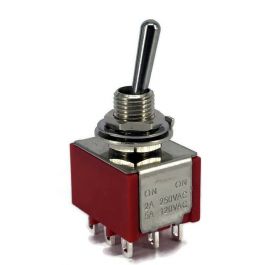mkstewartesq
Well-known member
OK, here’s something that seems like it would be relatively straightforward, but I can’t find any clear answer via Google: how to wire up a power on/off switch for a pedal, specifically one that will be driven by battery only (no DC jack).
I’m building a strap–mounted treble booster, which means that it will run exclusively on battery. Doing it the old-school way for treble boosters (no DC jack-the battery is connected or disconnected based on whether there is a plug in the input jack) doesn’t really work in this case because I plan to leave a short cable running from the guitar to the input jack at all times, and only plug into the output jack when I am actually using the guitar. So I’m really looking to wire up a toggle switch to turn the power on and off so the battery isn’t draining the whole time a cable is plugged in. All my searches have really only revealed how to use a DPDT for effecting bypass, which doesn’t really address the battery consumption issue (and, for my use case, I really don’t absolutely NEED a bypass state for this effect, as this guitar sounds great with a trouble booster but not so great without it).
Thanks,
Mike
I’m building a strap–mounted treble booster, which means that it will run exclusively on battery. Doing it the old-school way for treble boosters (no DC jack-the battery is connected or disconnected based on whether there is a plug in the input jack) doesn’t really work in this case because I plan to leave a short cable running from the guitar to the input jack at all times, and only plug into the output jack when I am actually using the guitar. So I’m really looking to wire up a toggle switch to turn the power on and off so the battery isn’t draining the whole time a cable is plugged in. All my searches have really only revealed how to use a DPDT for effecting bypass, which doesn’t really address the battery consumption issue (and, for my use case, I really don’t absolutely NEED a bypass state for this effect, as this guitar sounds great with a trouble booster but not so great without it).
- Any tips on how I would wire a switch between the battery and the board just to act as a simple power on/off to engage/disengae the battery?
- Having a switch would be my preferred solution so that I could just turn the pedal off during periods when I might want to leave both the input and output cable engaged (or forget to unplug them). Assuming that isn’t possible, however, is there any issue with having the battery run off of a switched jack on the output side, rather than the input side, so that the battery is disconnected when there is a plug inserted into the input jack but no plug in the output jack?
Thanks,
Mike


